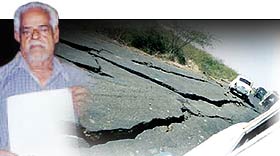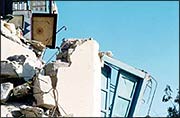The Rediff Special/ George Iype


Can earthquakes be predicted? Scientists and seismologists the world over say it is impossible. Eighty-year-old P N Nair, though, believes he has developed a scientific method that can predict both the general time frame and the location of an impending earthquake.
Though science may dismiss him, thousands of Kutch residents will now find it difficult to forget him. Earlier, when he predicted a devastating earthquake would hit Gujarat by the end of January, people pooh-poohed him. Then, when he published his forecast in the Gujarat daily, Kutch Mitra, on January 8, the experts dismissed it. Nair even tried his best to impress on the Gujarat government the seriousness of his findings, but the authorities ignored his warnings.
Which is why, today, Nair is a frustrated man. Though he is distraught that most of his friends and neighbours in Gandhidham have perished, he is relieved that his wife, two daughters, son and their children are safe; that his house there has escaped with only a few minor cracks. But, as he prepares to leave for Gandhidham where he has been living for the past 51 years, Nair is a hero among hundreds of villagers in the hilly area of Poonjar in Kerala's Kottayam district. The reason: when he landed there on January 24 to study the frequent tremors in Kerala's central districts, Nair predicted a major earthquake would hit Gujarat within seven days.
K N Ramachandran, in whose house Nair made the prediction, is yet to recover from the shock of finding out his guest was right. "On the evening of January 24, Nair said he could sense thunderous sound from within the earth. He then explained to me and others in the village that an earthquake would soon hit Gujarat. When that disaster actually happened on Republic Day, we were awestruck." Ramachandran is a retired deputy director of education in Kerala.
Nair denies any premonition about impending earthquakes. He adds that -- unlike what people are beginning to attribute to him -- he does not have any divine powers. "It is all scientific," he insists. "I can predict earthquakes scientifically. But I am sad that the authorities and the so-called seismological experts are unwilling to listen to me."
When and how did earthquakes begin to fascinate him so much that he made it the focus of his life? Nair, who then worked for the Military Engineering Services, was transferred from Kerala to Kandla in 1949. Seven years later, an earthquake measuring seven on the Richter Scale hit Gujarat, killing over a hundred people and displacing hundreds. "I was a victim of the earthquake that hit Kutch in 1956," he says. "I was wounded and our home was partially damaged. It was then that I resolved I would study earthquakes."
He began at night, standing barefoot on the land outside his house. And he would feel a sound, which he compares to that of a gunshot. Occasionally, he would even feel an electric shock go through his body. He read extensively on sound waves and the earth's movements. He researched the entire Kutch area. And then, in 1974, he announced what he called the Nair Effect Magnetic Field Theory. "There is a momentary lightening and thunder effect below the earth's crust when its plates collide. This produces a magnetic field, whose properties are different from the earth's geomagnetic field.
"The earth's crust is formed of plates. When these plates collide, the electrons move and a process of ionization takes place, aided by the high temperature below the earth's crust. The electrons start moving almost 40 days prior to an earthquake. Due to the frequent collision of plates in an earthquake prone area, the amount of electrons emitted increases steadily as does the temperature under the ground. The emitted electrons form of a magnetic field in the area surrounding the plate. Finally, a force is experienced on the earth's surface -- we call it an earthquake."
Nair says the traditional tectonic theory accepted by seismologists has many holes. "It does not explain the gap between the accumulation of pressure under the ground and the actual earthquake. Seismologists do not know what happens between these two processes. My theory fills this gap; it explains how a magnetic process takes place both inside and outside the earth before an earthquake actually happens."
 Nair claims that, seven days before an earthquake hits a region, one can scientifically spot the following indicators: A humming effect follows most sounds; swaying shock-waves; the rumbling sound of vehicles or falling objects; the audibility of distant sounds; echoes in the horizon; khar-khar sounds on the roads and flashes of light that move from right to left on television sets. Thunder-like sounds emanating from within the earth are the final signal that an earthquake is near.
Nair claims that, seven days before an earthquake hits a region, one can scientifically spot the following indicators: A humming effect follows most sounds; swaying shock-waves; the rumbling sound of vehicles or falling objects; the audibility of distant sounds; echoes in the horizon; khar-khar sounds on the roads and flashes of light that move from right to left on television sets. Thunder-like sounds emanating from within the earth are the final signal that an earthquake is near.
But how do these indicators help Nair decide the location of an earthquake? "The direction of these sounds can be scaled, depending upon their strength and force. Let me try to explain with a rough example. If you felt that these sounds were coming from, say one kilometre away, it is certain the earthquake would hit some 1,500 kilometers away."
How does he measure these sounds? Nair has created an harmonium-like instrument, powered by four batteries, that can feel the signals of an impending earthquake.
So how many earthquakes has he predicted? "Many," says Nair, opening a diary in which he has listed the times and the places of the earthquakes he has predicted. He said that, sitting in Kutch which was 3,000 kilometres away, he predicted the earthquake that hit Iran and Iraq two days before it happened. The quake registered five on the Richter Scale. He says he also predicted the 1992 Tokyo earthquake three days before it happened.
In the seventies, Nair wrote to then prime minister Indira Gandhi about his ability to predict earthquakes. She forwarded his request to the Indian Meteorological Department and other earthquake research centres. "But I did not get any response from them. Everyone thinks I am a prankster. If the government spends half the money it wastes on the countless number of scientists and seismologists who do no work across the country, I can develop a world-class research centre for earthquakes in India." But neither the government nor the experts have approved his theory.
Nair, though, has the support of the people of Kerala. In 1993, during one of his visits to the state, Nair said Kerala was earthquake-prone. On December 2, 2000, he predicted an earthquake would hit the state; the prediction was dismissed by the people of Kerala. On December 12 - just 10 days after Nair's prediction - an earthquake measuring 5.2 on the Richter Scale hit Kerala for the first time.
Since then, the Malayalam vernacular press has dubbed him Earthquake chettan (brother). In the last two months, Nair has held three press conferences. He has addressed a number of public meetings where he answers people's queries on earthquakes. He has received a handful of invitations from various cultural societies to talk about earthquake predictions. Nair, though, is preparing to return to Gandhidham. To take stock of the earthquake's aftermath. And to spread his theory about the future shocks that we can expect from the planet we call home.
Design: Dominic Xavier
The Complete Coverage | List of earthquake sites
Back to top